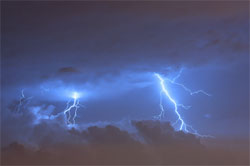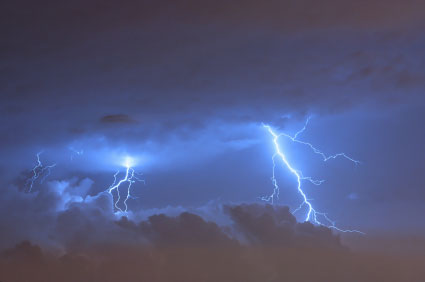Thunderhead Accelerator
Besides being host to stunning lightning displays, thunderclouds also emit gamma rays, although researchers aren’t completely sure why. Last fall, detectors installed on a mountaintop in Japan captured the first simultaneous observations of this radiation along with the high-speed electrons thought to be their source. The results, detailed in the 26 June Physical Review Letters, support the prevailing model of thundercloud accelerators generating “runaway” electrons, which may sometimes initiate lightning.
Since 1994, satellites, aircraft, and ground-based detectors have picked up gamma ray flashes from thunderstorms. They can last from a few milliseconds to minutes, but only the shortest ones appear to be associated directly with lightning strikes.
Experts believe the gamma rays come from electrons accelerated to near the speed of light in the strong electric fields of thunderclouds. When one of these fast electrons collides with an air molecule it slows down, causing it to emit a gamma ray photon as so-called bremsstrahlung radiation. To account for enough high-speed electrons, theorists have proposed that cosmic rays provide a “seed” population. As these primary electrons accelerate in a thundercloud’s electric field, they knock other electrons off of air molecules, and the newly liberated electrons accelerate and knock out still more electrons from atoms. This “runaway” avalanche model is consistent with short flashes, and it may provide the trigger for lightning strikes [1]. But it hasn’t been clear whether the model could also explain long-duration bursts.
To provide a new type of data set, Harufumi Tsuchiya of RIKEN, a Japanese research institute, and his colleagues built a system that could measure both the electrons and photons from a thunderstorm. Their main components were a sodium-iodide scintillator that could detect all incoming particles in the range of 10 thousand electron-volts (keV) to 12 million electron-volts (MeV) and a plastic scintillator sensitive primarily to electrons with 500 keV or more energy. Because these relativistic electrons travel at most a few hundred meters through the atmosphere, the detectors were placed 2770 meters above sea level at the Norikura Observatory, where low-lying thunderstorms are frequent.
During a storm on the night of 20 September 2008, the detectors picked up a radiation burst lasting 90 seconds, with no associated lightning strike. A computer model showed that the gamma rays–which were identified by subtracting the two scintillator signals–likely originated from 90 meters above the detectors. “Because of this short source distance, the accelerated electrons were able to arrive at our detector after escaping an acceleration region in the thunderclouds,” Tsuchiya says. The team’s estimated electron energies extending up to 20 MeV were consistent with the runaway model, suggesting that at least the energy predictions of the theory are reasonable for long-duration gamma-ray bursts.
From the electron counts, the authors also inferred the cloud’s accelerator to be 200 meters long. This length is shorter than might be expected from the runaway model, says Robert Roussel-Dupré, a science consultant in Santa Fe, New Mexico, who helped develop the model. He thinks an extension of the theory is needed to explain the size of the accelerator, the long duration of such bursts, and also the puzzlingly small electric fields measured by balloons flown inside thunderclouds. By current theories, these fields aren’t large enough to initiate lightning. A clearer picture of long-duration bursts could connect runaway electrons to the lightning spark.
–Michael Schirber
Michael Schirber is a Corresponding Editor for Physics Magazine based in Lyon, France.
References
- J. R. Dwyer, M. A. Uman, and H. K. Rassoul, “Remote Measurements of Thundercloud Electrostatic Fields,” J. Geophys. Res. 114, D09208 (2009) [see Cosmic Rays Offer Clue to Lightning (news article at Physicsworld.com)]





